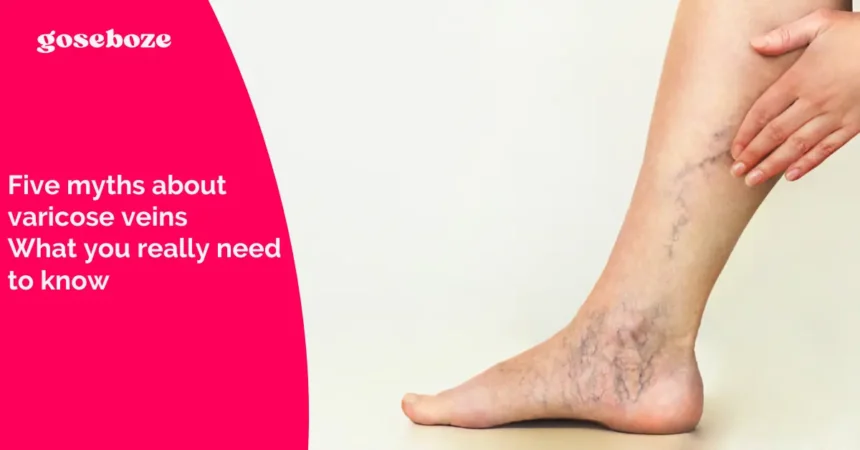Varicose veins are a common condition, but they’re shrouded in myths and misunderstandings. While many people believe they know what causes them or how to treat them, the truth is often more surprising.
From age-old misconceptions to modern-day myths, these false beliefs can prevent people from getting the right care and understanding the real risks. In this article, we’ll uncover the truth behind some of the most common myths about varicose veins.
It is a common misconception that varicose veins are an inevitable part of aging, something that only affects the elderly. While age can be a contributing factor, varicose veins are not exclusive to older individuals. In fact, people of various ages, including younger adults, can develop varicose veins due to factors such as genetics, prolonged periods of standing, pregnancy or even hormonal changes.
Though the likelihood of developing varicose veins increases with age, they can appear as early as your 20s or 30s, especially if a family history or lifestyle factors are involved. So, the idea that varicose veins are solely an age-related issue is not only misleading but could also lead younger individuals to overlook early signs of the condition.
Myth No. 2 – Varicose veins are just a cosmetic problem
Many people believe that varicose veins are nothing more than a cosmetic issue, but this is far from the truth. While it’s true that varicose veins can affect appearance, they can also signal underlying vascular issues. Left untreated, they can lead to more severe health complications such as:
- Chronic pain: Persistent discomfort or aching in the legs, which can worsen with standing or walking.
- Swelling: Noticeable swelling in the legs or ankles, often accompanied by a feeling of heaviness.
- Skin ulcers: Painful sores or ulcers near the ankles, which can be difficult to heal.
- Deep vein thrombosis (DVT): A serious condition where blood clots form in the deep veins of the legs, posing a risk of breaking off and traveling to the lungs, which can be life-threatening.
Varicose veins indicate that blood flow is not functioning properly in the affected veins, which means that the circulatory system may be compromised. Addressing the issue early is crucial not only for aesthetic reasons but for maintaining overall vascular health. It’s important to recognize that varicose veins may require medical intervention beyond cosmetic treatment.
Read Also: Tech Innovations That Are Transforming Customer Experience
Myth No. 3 – Crossing your legs causes varicose veins
One of the most pervasive myths is that crossing your legs causes varicose veins. While this belief is widespread, there is no scientific evidence to support it. Varicose veins are primarily caused by factors such as genetics, prolonged standing or sitting, obesity, pregnancy, and age. Not by sitting with your legs crossed.
The development of varicose veins is linked to weakened or damaged valves within the veins, which prevent blood from flowing efficiently back to the heart. This leads to blood pooling, causing the veins to swell and become varicose. Crossing your legs may contribute to temporary discomfort or poor circulation if you’re sitting for extended periods, but it does not directly cause the valve dysfunction that leads to varicose veins.
To reduce your risk of varicose veins, focus on lifestyle habits that promote good circulation, such as:
- Maintaining a healthy weight to reduce pressure on your veins.
- Staying active, with regular exercise to improve blood flow.
- Elevating your legs periodically to reduce pooling of blood.
- Avoiding prolonged sitting or standing whenever possible.
By focusing on these factors, you can help keep your veins healthy and reduce the likelihood of developing varicose veins.
Myth No. 4 – Varicose veins only occur in women
Although it’s often believed that varicose veins only affect women, this condition is not gender-specific. While women are more likely to develop varicose veins due to hormonal factors, men are by no means immune. In fact, research shows that a significant percentage of men also suffer from varicose veins, though they may be less likely to seek treatment due to societal perceptions.
Factors like genetics, lifestyle, and occupation affect both men and women equally. Professions that require prolonged standing or heavy lifting can increase the risk for both genders. Unfortunately, because varicose veins are often associated with cosmetic concerns, men might delay addressing the issue, even when symptoms like pain or swelling appear.
Myth No. 5 – Surgery is the only treatment for varicose veins
Many people assume that surgery is the only way to treat varicose veins, but this is no longer the case. Modern medical advancements have introduced a variety of non-invasive treatments that can effectively address varicose veins without the need for traditional surgery. Today, patients have access to less invasive options, including:
- Chemical ablation
- Laser therapy
- Sclerotherapy
- Radiofrequency ablation
- Compression therapy
When is surgery necessary for varicose veins?
Varicose veins can range from mild discomfort to significant medical issues that require surgery. In more advanced cases, where symptoms like persistent pain, heavy swelling, or skin ulcers occur, surgery may be the best solution. When untreated, severe varicose veins can lead to complications such as venous insufficiency, chronic pain, and increased risk of blood clots, making surgery essential to prevent further deterioration.
Dr. Ahmed Farah, a skilled vascular surgeon, specializes in treating advanced cases where surgery is necessary. His approach often involves removing or closing off affected veins, improving circulation, and relieving discomfort. For patients whose varicose veins have progressed to this stage, surgery can offer significant relief and restore their quality of life.
Consulting an expert like Dr. Ahmed Farah ensures you receive the most appropriate treatment for your condition. If you’re interested in learning more about preventing or treating varicose veins, or when surgery might be required, you can explore Dr. Farah’s insights.
Understanding the truth about varicose veins is essential for proper care. While many myths persist, knowing when to seek professional advice can make all the difference. Whether through non-invasive treatments like chemical ablation or surgery, addressing the issue early with the right guidance is key to long-term relief.








